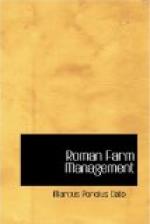XXVI. “In all vineyards care is taken that the prop should shelter the vine against the north wind. And if live cypresses are used as props they are planted in alternate rows and are not allowed to grow higher than is necessary for use as a prop. Cabbages are never planted near vines because they do each other damage.”
“I fear,” said Agrius, turning to Fundanius, “that the Sacristan may get back before we have reached the fourth head of our subject, that of the vintage, for I am looking forward thirstily to the vintage.”
“Be of good cheer,” said Scrofa, “and prepare the grape baskets and the ewer.”
4 deg. CONCERNING THE AGRICULTURAL SEASONS
XXVII. We have two standards of time, the first that of the revolution of the year, because in it the sun completes his circuit, the other the measure of the month, because it includes the waxing and the waning of the moon.
Of the solar measure of the year
First I will speak of the sun, whose recurring journey is divided with reference to the pursuits of agriculture into four seasons of three months each, or more accurately into eight seasons of a month and a half each. The four seasons are Spring, Summer, Autumn and Winter. In Spring certain crops are sown and the sod fields are broken up,[82] so that the weeds in them may be destroyed before they have seeded themselves again, and the clods, by drying out in the sun, may become more accessible to the rain and when broken down by its action easier to cultivate. Such land should be ploughed not less than twice, but three times is better.[83] The Summer is the season of the grain harvest; the Autumn, when the weather is dry, that of the vintage: and it is also the fit time for thinning out the woods, when the trees to be removed should be cut down close to the ground and the roots should be dug up before the first rains to prevent them from stooling. In Winter the trees may be pruned, provided this is done at a time when the bark is free from frost and rain and ice.
XXVIII. Spring begins when the sun is in Aquarius, Summer when it is in Taurus, Autumn when it is in Leo, and Winter when it is in Scorpio. Since the beginning of each of the four seasons is the twenty-third day after the entrance of the sun in these signs respectively, it follows that Spring has ninety-one days, Summer ninety-four, Autumn ninety-one and Winter eighty-nine: which, reduced to the dates of our present official calendar,[84] makes the beginning of Spring on the seventh day before the Ides of February (February 7), of Summer on the seventh day before the Ides of May (May 9), of Autumn on the third day before the Ides of August (August 11), and of Winter on the fourth day before the Ides of November (November 10).




